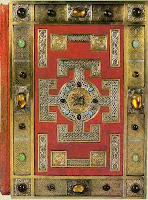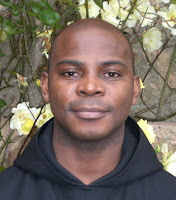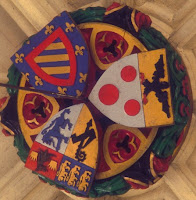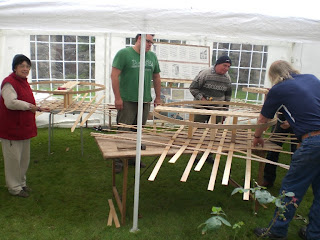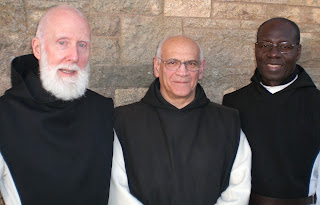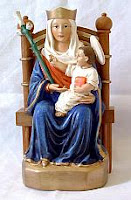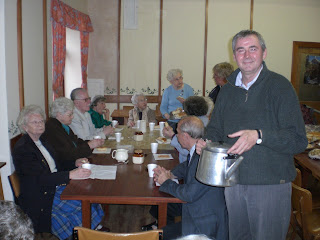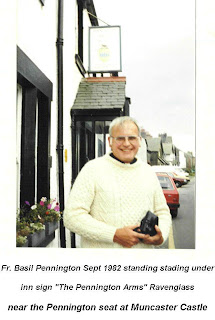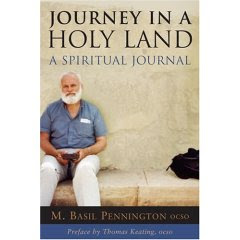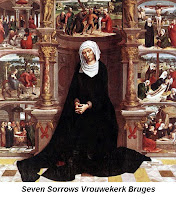2002 for the Record.
Christmas PAST
An old copy of an article on Nunraw's Christmas five years ago was handed in for our archives. The East Lothian Courier (www), December 20,2002
Meat on the menu and ‘Harry Potter’ for entertainment the monks of Nunraw prepare for Christmas
The festival of Christmas is upon us once again, but as we run around the crowded streets, desperately trying to buy multi-pack gift sets and enough food to last a lifetime, there is generally a nagging feeling that there is something perhaps forgotten.
So often the very reason for Christmas - a celebration of the birth of our Saviour Jesus Christ is lost among the mountains of wrapping paper and glittering decorations, But there will be many who take time to reflect that Christmas means much more than trinkets and baubles. And none more so than the monks at the Sancta Maria Abbey, Nunraw, near Garvald.
Yet, although Christmas is naturally a special time of year for them, it changes remarkably little with regard to their routine of daily life. The community of Cistercian (Trappist) monks was established in 1946 and between 1952-69 they constructed the Abbey itself, with the help of volunteers from the village. An impressive yet simple structure, the building was designed by architect Peter Whiston RSA, who drew inspiration from many of the beautifully kept ruins of Cistercian monasteries which dot the British countryside.
"'When I first arrived here 50 years ago there was little more than. a hole in the ground," said Abbot Donald McGlynn. "I am actually reminded of it when I see the site of the Scottish Parliament. Whenever anyone comes to visit me in Edinburgh I take them to see it, telling them all about our history and how this is a symbol of our new democracy - but it's just a great big hole in the ground!"
Quadrangle
The foundation stone of the Abbey was laid in 1954 by Archbishop Gray and over the following years it was shaped into the simple retreat it is today. The main part of the building, the cloisters, are a convenient quadrangle of passages- surrounding a garden, the cloister garth which connect the living. studying and worshipping areas. The chief purpose of the design is to join the monastery as a whole to the church, the 'heart of the community, but over the years they have come to be respected as places of silence for reflection and prayer.
The library is another important aspect in the life of the abbey. A monk, almost from his first days in the monastery, is put "in touch with the Bible, liturgical books. monastic writings. theology and philosophy, and the library has accumulated an astonishing range of literature.
The monks always welcome new people into their order, but anyone thinking of joining should perhaps be told a little of what their lives entail. The Abbot is the leader and the teacher of the community. His burden is to lead his brethren in living out as fully as possible the ideal of the Christian community.
The chief ·activity of the monastic day is the celebration of Mass and its extension, the Divine Office. Cistercians have always treasured the hours before dawn for communal and private prayer, and the community rises 15 minutes before starting Vigils in the Church at 3.30am. After Vigils there is a half-hour's private prayer, leading into the community Mass which starts at 4.40am. After breakfast there is another interval for private prayer or study closing with the dawn office of Lauds.
Working day
At the end of Lauds comes the start of the ‘working day’, which entails the normal house-keeping chores - the running of the farm, the guesthouse and the shop by which the community earns its keep. The rest of the Divine Office accompanies these labours - three prayer sessions ending with the Compline which begins the Great Silence, strictly kept until Lauds the following day. The monks do not take a vow of silence but during the day they are well minded by the advice of St Benedict: 'The wise man is known by the fewness of his words'. Then at 8pm they are off to bed.
Reporter Gareth Edwards left the festive rush and push behind to take stock and contemplate the true meaning of Christmas in the company of the monks at the Sancta Maria Abbey. Here he describes how they plan to spend Christmas with Fr. Randolph in charge of cooking lunch, and the possibility of a special treat, a video movie, to roung off the working day
With so much to occupy them during every day of the year it is small wonder that little changes at Christmas.
"Our days are all so special anyway that to add anything more to them would be almost impossible," said Fr McGlynn. "Over Christmas we might start the day a little later than normal. On Christmas Eve we hold a midnight Mass, and a few of us usually attend the celebrations in the Village Kirk. There is normally a nativity service with the children of the village, and after that we have a procession through the village led by a brass band."
Sleeping
Of the 17 monks at the Abbey, those who do not attend the village celebrations are understandably, sleeping. On Christmas morning, after their usual morning prayers and worship, it is the job of Father Hugh Randolph to prepare the Christmas lunch, while the other monks attend to the daily tasks. Father Randolph is also the head tailor, making all the traditional robes for the monks, which remind them of their consecration to God and help them to maintain a close community spirit.
And he has no problem about being stuck in the kitchen, as it is sure to be one of the warmer places in the monastery.
"It is quite cold in parts of the monastery." he said. "The church is very warm, as is the library, because we can only afford to heat certain parts of the building.- When we built the place 50 years ago we had oil burning heaters installed as that was the cheapest way of heating it at the time. Of course because of the Gulf War, and other things; gas is a lot cheaper, but· we cannot really get it out here.”
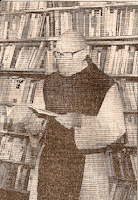 The Library-at Nunraw Abbey is one of the most important parts of the building, with monks such as Father Hugh Randolph able to access a wide range of literature on theology, monastic writings and philosophy.
The Library-at Nunraw Abbey is one of the most important parts of the building, with monks such as Father Hugh Randolph able to access a wide range of literature on theology, monastic writings and philosophy.
"It is quite a treat as we are normally vegetarian and it is only on very special days that we eat meat," said Abbot McGlynn. "The cows are raised and cared for from birth to slaughter and we pass them on to the butchers for money. It is a natural organic beef as there are no chemicals or pesticides used. We do not eat them ourselves however, and ill fact a lot of the food we eat at Christmas is given to us as a gift, or purchased from a wholesale grocers."
Vegetarian
The vegetarian diet, maintained throughout the year except on special community occasions or for any sick members of the order, is part of the teachings of the Cistercian monks and is rooted in their history.
Monks first emerged as a special type of Christian in Egypt and Syria towards the end of the third century. One stream of monasticism later flowed into the Celtic tradition and is associated chiefly with such famous monks as Brendan, Columbanus and Columba of Iona.
Another flowed into Italy and it was here that St Benedict wrote his Rule for Monks which in time supplanted all other rules in the West. St Benedict saw monks’ daily-life as a prudent balance between prayer, work and prayerful reading, with the community to be a school of charity.
In 1908 a group of Benedictine 'reformers' founded the monastery of Citeaux. After a difficult beginning the austere life of Citeaux flourished, particularly after the entry of St Bernard in 1113. He became the most celebrated monk of the 12th century and his many writings have an enduring value.
The golden period of the first centuries suffered decline as wars, the Black Death, the reformation and the French Revolution all took their toll. The monastery of La Trappe, however, maintained the strict observance and eventually gave rise to the Trappist Congregations, which in 1892 were united in the Order of Cistercians of the Strict Observance, or Trappists.
The Cisterclans first came to Scotland in 1136, founding an abbey at Melrose. They subsequently set up another ten abbeys and nine convents of nuns, the largest of which was at Haddington. In 1560 the monastic life in Scotland was suppressed. It was re-established in Ireland at Mount Melleray in 1832. From there Roscrea Abbey was founded in 1878 and it, in its turn, sent a colony of monks to found Nunraw in 1946.
The guest lodge run by the monks is also part of the Benedictine tradition. St Benedict said: "Let all guests be received like Christ himself, for He will say: 'I was a stranger and you took me in”. Over Christmas it is generally very quiet. with most people spending time with their families, The busiest part of the season at the Lodge is the annual party held for residents of·the village.
"The whole of the village helps organise the party and come along to enjoy themselves," said Father Randolph. "It started off as something for the OAPs. who still get in free. Everyone else is asked for just a small amount and we had a lot of youngsters and a."lot of new faces to the village this year. It is a very good community effort and it helps us keep up a good relationship with the village."
In contrast to Christmas, however, New Year is one of the busiest times of the year for the Lodge, with more than 40 people staying there and many more asking for rooms. The Millennium New Year was booked out almost a year in advance, although whether that had anything to do with end-of-the-world paranoia is not known.
Quiet carols
"People come here at New Year to find a bit of peace and quiet, to get away from it all," said Fr McGlynn. "The city offers the biggest party in Europe, I think and it is such a binge of excess. What we offer is, in effect the complete opposite, with some quiet carol singing at a midnight Mass. I think more and more people are looking for an alternative to partying at New Year and certainly we are always busy."
The -amazing views offered from the hillside Abbey certainly provide peace and tranquillity in abundance, and the annual fireworks display in Edinburgh can be seen if it is a clear night.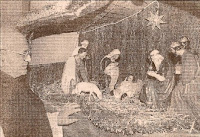
Father Raymond Jaconelli admires the nativity scene at the entrance to the guest lodge at the Sancta Abbey, Nunraw. While the lodge is normally quiet during Christmas it is full almost every New Year, as an alternative to the endless parties.
Whine the monks have given up: most of the needless trappings of everyday modern life, they are not completely isolated from life. They have a website, nunraw.org.uk, through which they receive queries about their life from around the world. There have even been requests for a webcam allowing people to join in their services, although Fr McGlynn thinks this might be a step too far,
This year, after saying a prayer of thanks for the bountiful feast prepared by Father Randolph, the monks will have free time to do what they wish. Father McGlynn is thinking about a video.
"We might watch a movie in the evening this year, but we are so far behind in these things”, he said. “I was going through the airport recently and they had all these videos and DVDs. I saw two, 'Harry Potter and the Philosopher's Stone' and 'The Lord of the Rings", so I bought them and we might watch one. It will certainly make a nice change. I heard about all these people who denounced both of the films for promoting black magi, but I think myths and legends have an important place in society, so I don't have a problem with them”.
 Even Abbot Donald McGlynn leader of the community of Cistercian monks at the Sancta Maria Abbey Nunraw, has to get his hands dirty helping out with the variety of jobs which fill up their daily lives including looking after the farm.
Even Abbot Donald McGlynn leader of the community of Cistercian monks at the Sancta Maria Abbey Nunraw, has to get his hands dirty helping out with the variety of jobs which fill up their daily lives including looking after the farm.





